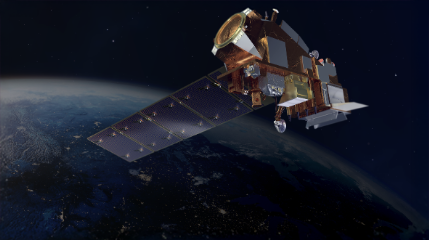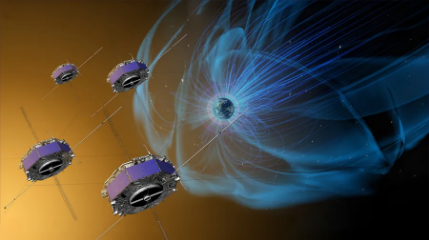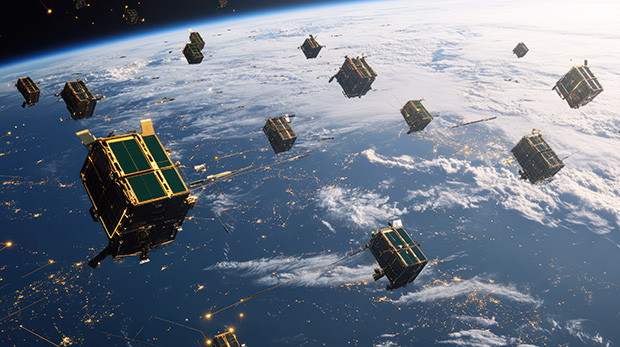Constellation Management
SOLUTIONSa.i. solutions has a long heritage in providing services and software solutions for both small and large satellite constellations. Our expertise spans mission planning and design, satellite operations, analysis and assurance.
Synchronizing spacecraft
Constellations comprise of multiple spacecraft or satellites that are intentionally operated in tandem to achieve a common objective. Examples include:

Data/Communication Constellations

Navigation Constellations

Earth Observation Constellations
Constellation choreography
Constellation management involves coordinating the orbits of all satellites in the constellation, identifying and resolving anomalies, staffing the ground system, automating operations, and much more.
As more and more spacecraft are added to constellations (Starlink will consist of 12,000 satellites) the challenges associated to managing the operations also increases significantly. At a.i. solutions, we understand this challenge and have been providing solutions for constellation management since 2006.

Constellation maintenance
To ensure constellation objectives are met, operators must manage parameters such as constellation shape, satellite spacing or inter-satellite links, and altitude. The ground system must provide efficient maneuver planning tools, state-of-the-art orbit determination, and extremely accurate long-term orbit predictions.
Contact our team to learn more about our constellation management solutions
Scale and automate
For larger constellations, routine tasks may need to be repeated many times for each satellite, and the life cycle of individual satellites must be managed.
This means the constellation must continue operating normally during launch and orbit insertion of a new satellite and during de-orbiting of a satellite as it is retired from the constellation. FreeFlyer can be used to automate tasks for any number of spacecraft simultaneously. Whether automating daily tasks that would be intractable for a human to perform or scaling operations as constellation size grows, a.i. solutions has the tools and team to achieve mission success.

Contact planning
Planning contacts can be challenging for any satellite in orbit, let alone for many satellites grouped in a constellation.
It all starts with modeling ground stations and satellite antennae to determine line of sight and radio visibility, though complexity quickly grows when accounting for data relays or additional contact requirements such as:
- Live data relaying between satellites within the constellation
- Usage of communication networks such as the Tracking and Data Relay Satellite System (TDRSS)
- Frequency or continuity of contacts for the constellation as a whole
Contact planning considerations like the ones above are addressed easily and reliably with FreeFlyer’s pre-defined and customizable ground station profiles, easy-to-use chain visibility calculations, and advanced sensor modeling.
Conjunction assessment within a constellation
Satellite conjunction assessment is necessary within a constellation. When multiple satellites share a similar orbit regime, probabilities of collision can increase significantly, and so regular conjunction screening is a must.
Coordinating with an external conjunction assessment service such as NASA’s Conjunction Assessment Risk Analysis (CARA) is quite common for evaluating mission assets against space debris or other spacecraft. However, it does not make sense to offload intra-constellation assessments to those services due to the increased cost and complexity.
Intra-constellation collision avoidance can be built into regularly planned maneuvers, and unplanned collision avoidance maneuvers can be executed with quicker turnaround.
FreeFlyer makes conjunction assessment a breeze with specialized tools like the ProximityZone. This makes FreeFlyer ideal not only for passive screening but for integrating intra-constellation collision avoidance directly into the planning process – all within the same software. FreeFlyer also excels at generating visualizations of space objects and conjunction events, improving operators’ understanding and elucidating the situation.

A unique example: NASA’s Magnetospheric MultiScale (MMS) Mission

Not only does a.i. solutions offer services and software products for constellation management, but we have experience flying satellites in record-breaking precision formation. NASA’S MMS mission, powered in part by FreeFlyer, is a formation of four satellites flying in a tight tetrahedral configuration.
Launched in 2015 and originally intended to last two years, the mission has been extended several times and continues to provide invaluable scientific data about phenomena within the earth’s magnetosphere. MMS holds multiple world records in spaceflight including the closest separation of any multi-spacecraft formation, at less than 8 km apart. These achievements were made possible through innovative navigation and maneuver planning techniques.


